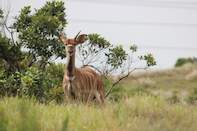
Located in the Eastern Cape, the Great Fish River Nature Reserve takes its name from the Great Fish River that winds its way slowly through the landscape gouging deep gorges through the rock and providing ample water for the wildlife and spectacular views.
The Landscape of the Great Fish River
The Great Fish River Nature Reserve is made up of the Andries Vosloo Kudu Reserve, the Sam Knott Reserve and the Double Drift Reserve. It covers a total of 45 500 hectares of land. Located in the Eastern Cape equidistant from Grahamstown and King William's Town, the reserve ranges from 95 metres above sea-level to 561 metres above sea-level and consists mainly of steep cliffs dropping down into river valleys and broken inter-basin ridges. Most of the wilderness reserve is made up of Great Fish subtropical thicket.
Ancient Settlers
The north-west boundary of the reserve is formed by the Keiskamma River and the Koonap and Kat Rivers both flow from the north-east, eventually meeting in the north at the Great Fish River. There are a number of Later Stone Age sites and San Rock paintings found within the nature reserve showing that mankind has been in the area for many years. The Khoekhoen also settled in the area until around 1700 AD when other tribes from the north, including the Xhosa and the MFengudrove them out.
The Frontier Wars
White settlers later displaced these tribes when they arrived in 1812.The Boers followed in 1820 and the 19th century saw much conflict in the area as the various groups fought to establish ownership of the land. These battles became known as the Frontier Wars and today visitors to the area can see evidence of these battles particularly at Double Drift, Willshire and Botha's Post in the graves and forts found within the reserve. The Great Fish River formed the disputed boundary between the whites in the west and the local tribes in the east.
Unique Plants and Vegetation
Most of the exposed rock found in the nature reserve is sandstone but in the valleys and along the rivers one will find softer mudstone. Most of the area is covered in Great Fish thicket which is made up of 12 different types of vegetation and is very dense and difficult to penetrate, hence the large game animals such as Rhinos and Buffalo do well here as they are powerful enough to push through it. Prominent plants found in the area, especially on the slopes, include honey euphoria, river euphoria and a number of aloes such as the bitter aloe and the climbing aloe. The game animals feed mostly on the porkbush and spekboom.
What Wildlife Can You See in the Great Fish River Reserve?
There are at least 68 species of mammals found in the nature reserve and this includes one of South Africa's largest populations of Black Rhino. Today there are over 100 Black Rhino found in the reserve. Originally founded to conserve the Greater Kudu, these antelope are now commonly seen within the wilderness reserve. There are also over 400 'disease free' Buffalo found in the park as well as a number of antelope species including Red Haartebeest, Common Eland, Springbok, Blesbok and Steenbok.
The one animal you will not be able to miss in the park are Warthog as they are found in abundance. Of the large hunters, Leopard and Brown Hyaena are in the reserve but are seldom seen and visitors may see and will often hear the call of the Black-backed Jackal.
The Birding Experience
Bird-watching is a popular activity in the wilderness park and there are over 247 species of birds found here. The best bird watching is often had around the camps and picnic grounds. There are several exotic fish found in the reserve including Sharp-tooth Catfish and Large-mouthed Bass.

 Known for its outstanding natural scenery with panoramic views out over the Great Fish River, the Great Fish River Nature Reserve is home to...
Known for its outstanding natural scenery with panoramic views out over the Great Fish River, the Great Fish River Nature Reserve is home to...